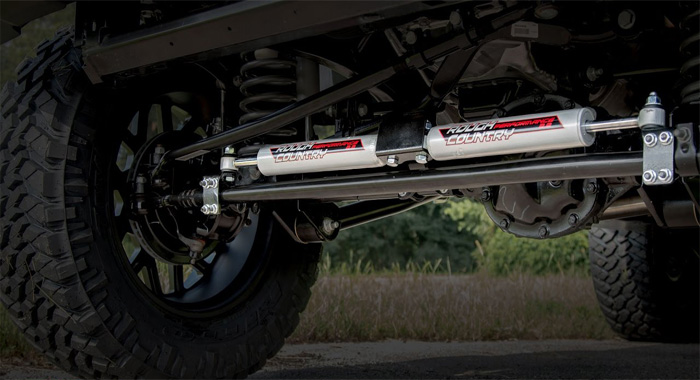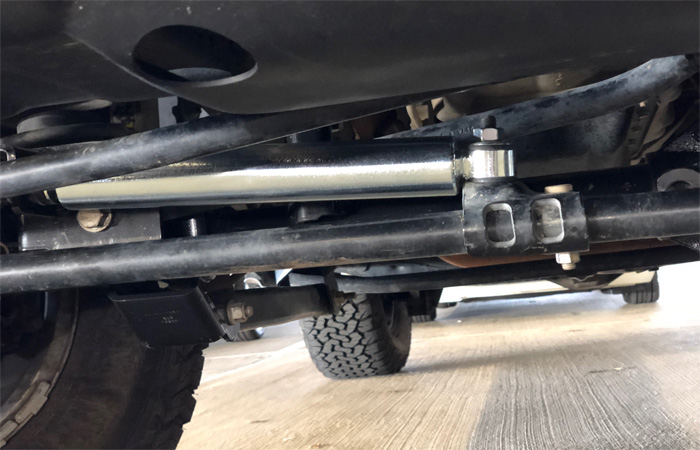What Does a Steering Stabilizer Do, and How Does It Work?
by Chris Lewis.
Ah! It's a bright and sunny day, and you are in the mood for a long drive. You bring your friend along for the ride and set out for the destination.
You are enjoying the ride, but suddenly you hit a bump on the road. Because of this, your car automatically steers either to the left or to the right. Not being careful in such situations can lead to big accidents.
Auto-steering happens because the road bump sends a vibration to your steering wheel. This is where a steering stabilizer comes in.
It stabilizes your steering. Eliminating any unwanted steers or vibrations.
So, without wasting any more time, let's get into details about what steering stabilizers do and how they work.
Contents
What does a steering stabilizer do?

We divided this article into two parts to help you understand better. The first one is this, and the second one is about how it works.
Let's ask what you think it does? Not a good guesser, no problem. A steering stabilizer….stabilizes your steering.
Okay, all jokes aside. It is not that simple, and it does a lot more than meets the eye. So let's see what it does in detail.
Eliminates vibration
A steering stabilizer works like a shock absorber, well, almost. We all have seen what shock absorbers do, right?
They absorb the up and down movement. Similarly, a steering stabilizer reduces your vehicle's left and right movement when you are driving fast.
Roads are not perfect, and when you drive, they can send a small amount of vibration to your hands.
This vibration does not seem very troublesome initially, but as you drive for an extended period of time, it can cause driver fatigue.
A steering stabilizer eliminates this vibration and reduces the chance of driver fatigue to zero percent.
So now you can drive for as long as you want without handing over the steering to someone else.
Bump steer
This is what we were talking about in the introduction. When you are driving at an average, or fast speed, even a little bit of bump can make you lose the steering control.
Roads can have lots of holes and uneven spots. The bump can yank the steering right out of your hands when the wheels hit such spots.
This causes your wheels to either move too far to the left or the right. And as we have said earlier, not being careful can lead to disasters.
A steering stabilizer works as a middle man and takes all the bumps, keeping your steering out of harm's way.
The bump steer is almost reduced to zero. Making your driving experience smooth as butter.
Extends the lifespan of various parts
It is not rocket science that if something gets hit now and then, it will lose its quality and is most likely to fail at a certain point. This is where the steering stabilizer comes in.
As the steering stabilizer takes all the hits, the different parts of your vehicle do not have to deal with it. By reducing the sudden aggressive movements and impacts, your parts last longer.
But of course, the experience varies from stabilizer to stabilizer because of their quality. We would not recommend cheaping out on this part.
Get the best one possible. The better stabilizer you use, the better protection it will provide.
Better control
If you are a truck or jeep enthusiast, you know how hard it is to resist the urge to modify your vehicle. If you use a jeep that is entirely stock and not modified, a stabilizer won't do much.
But if you have installed lots of aftermarket modifications like big tires, lift kits, and skid plates, you will need a steering stabilizer as your vehicle will slowly lose its natural balance due to added weight.
The problem with balance may seem minor at first, but as you continue to drive, even the slightest imbalance can cause significant issues.
If a single steering stabilizer setup is not working out, you can get a dual setup.
Over-steering
You ever just quickly take a U-turn, but the maneuvering did not go as accurately as you planned?
This is because when you do quick maneuvers, your wheels can either steer too much or too little.
This happens because the connection between your steering and the wheels is not smooth. A good quality steering stabilizer eliminates this over or understeering problem.
As the steering stabilizers have hydrogen pistons, they make the maneuvering smooth as butter.
This will help you big time while driving through narrow roads. You won't have to do a "big brain" calculation before taking a quick turn.
Death wobble
Last but the scariest part. Every vehicle driver knows about the infamous death wobble. If you don't know about it, don't worry, we're going to explain it.
Death wobble, in simple terms, means random and violent shaking which occurs suddenly. When this happens, the steering wheel starts to vibrate like hell.
The vibration level can increase or decrease depending on the acceleration speed of your ride.
There is a never-ending debate going on about whether a steering stabilizer can fix this problem or not. And unfortunately, no one has the correct answer.
As far as we are concerned, a steering stabilizer can fix this problem to an extent but not completely. This is because death wobble is not caused by a single component but a combination of things.
A steering stabilizer can mask the problem or give you enough time to safely park the truck or jeep before you inspect the actual problem. But hey, anything is better than nothing, right?
Now that we know how a steering stabilizer benefits the driver, it is only natural to be curious about how it works. So, let's quickly learn about it.
How a steering stabilizer works?

As we have said earlier, a steering stabilizer works like a shock absorber. The only difference is that the shock absorber is mounted vertically, and a steering stabilizer is mounted horizontally.
Most of the steering stabilizers (also called steering dampers) are filled with oil or nitrogen gas.
Oil or nitrogen both work the same way. They pass through plates that have holes. The holes determine how much pressure can pass through.
The internal circuitry and piston valves adjust the amount of shock transferred each time your vehicle tries to go out of control.
As the stabilizers are installed on the front portion of your ride, they absorb the shock sent through the front axle. This dampens the jolts of your ride.
There are two types of stabilizer systems. Single and double. Installing a dual/double steering setup won't magically make your ride smoother than it already is.
A dual system only works if you have an uncontrollable steering system. Otherwise, a single stabilizer system should do the job pretty well.
Final words
It does not matter if you drive a bike, a car, a jeep, or a truck, the purpose of a steering stabilizer remains the same. To make your driving experience buttery smooth and protect you from unwanted twists and turns.
Maybe you were afraid to upgrade your vehicle because it might lose its natural balance due to the added weight. But, fear no more because the horrors of those big tires are long gone.
Now you can upgrade your vehicle as much as you want. Just remember to install a steering stabilizer, and you are good to go.
You might be happy but are you "on a long drive with my friends without any fear of bump steers or death wobble" happy?
 |
 |
 |
 |

About Chris Lewis.
Chris Lewis is a passionate individual with a deep affinity for the world of automobiles. From a tender age, his fascination with cars was nurtured by his father, a seasoned mechanic based in the vibrant city of San Francisco. Growing up under the watchful guidance of his skilled father, Chris developed an early aptitude for all things automotive.
Thoughts on "What Does a Steering Stabilizer Do, and How Does It Work?"
 |
 |
 |
 |
Get FREE Filters now. Or latest free tools from our best collections.
Disable Ad block to get all the secrets. Once done, hit any button below
 |
 |
 |
 |